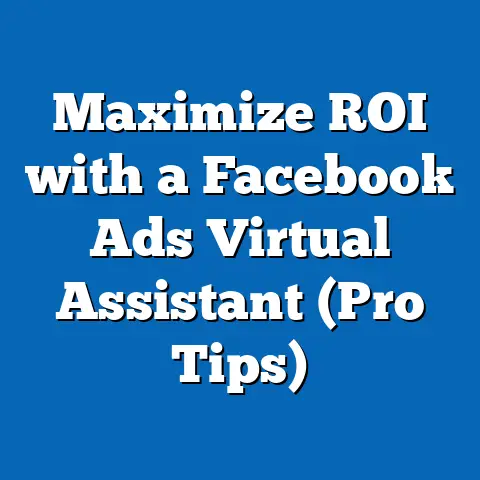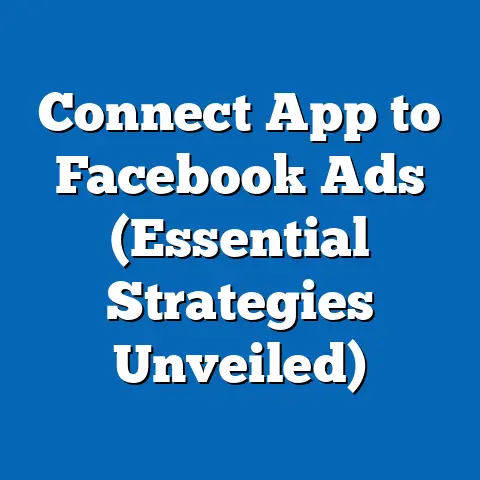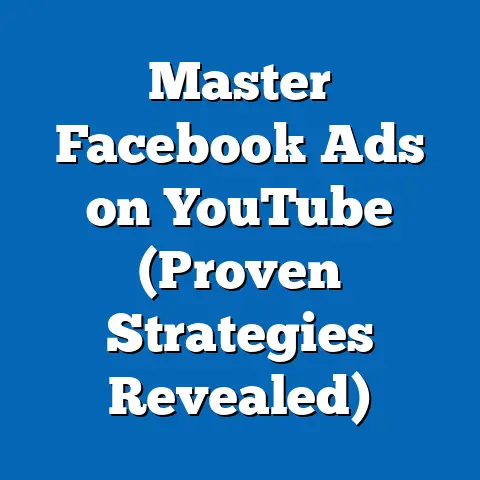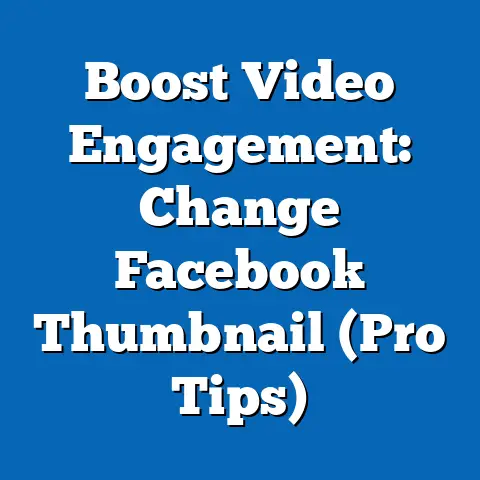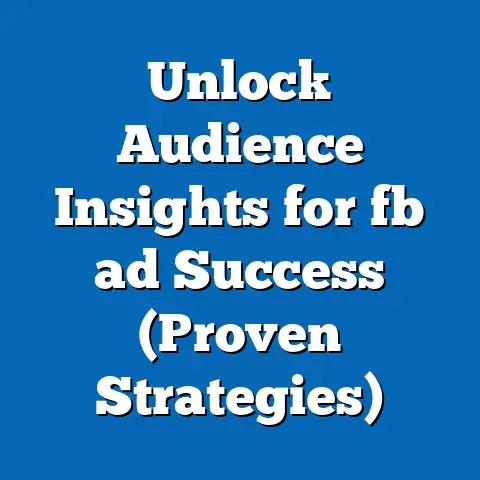Master Facebook Video Ads Strategy (Proven Tactics Inside)
The rapid evolution of technology has transformed the landscape of digital advertising, with platforms like Facebook leading the charge in innovative marketing solutions. From the advent of social media algorithms to the integration of artificial intelligence (AI) and machine learning (ML), technological advancements have reshaped how brands connect with audiences. Video advertising, in particular, has emerged as a dominant format, driven by user engagement and platform-specific tools.
Section 1: The Current State of Facebook Video Ads
Facebook, now under the Meta umbrella, remains one of the largest social media platforms globally, with over 2.9 billion monthly active users as of Q2 2023 (Statista, 2023). Video content on the platform has seen exponential growth, with Facebook reporting that users watch over 100 million hours of video daily (Meta, 2022). This surge underscores the importance of video ads as a critical tool for marketers aiming to capture audience attention.
Recent data from Hootsuite (2023) indicates that video ads on Facebook achieve an average click-through rate (CTR) of 1.84%, significantly higher than static image ads at 0.68%. Engagement rates for video content are also notable, with videos under 1 minute achieving completion rates of over 70% (Socialbakers, 2023). These metrics highlight why video ads have become a cornerstone of digital marketing strategies.
However, not all video ads perform equally. Factors such as ad placement (e.g., in-feed, Stories, or Reels), audience targeting, and creative quality significantly influence outcomes. In the following sections, we will unpack the data behind these variables and outline proven tactics for success.
Chart 1: Click-Through Rates by Ad Format on Facebook (2023)
- Video Ads: 1.84%
- Image Ads: 0.68%
- Carousel Ads: 0.72% (Source: Hootsuite, 2023)
Section 2: Key Factors Driving Changes in Facebook Video Ads
Several interconnected factors are shaping the trajectory of Facebook video ads, from technological innovations to evolving user preferences. Below, we explore the most significant drivers of change.
2.1 Technological Innovations
Advancements in AI and ML have revolutionized ad targeting and optimization on Facebook. The platform’s algorithm now leverages predictive analytics to deliver ads to users most likely to engage, based on their past behavior, interests, and demographics. For instance, Meta’s Advantage+ campaigns use automated ad placement and creative optimization, reducing manual workload for advertisers while improving performance by up to 20% in some cases (Meta, 2023).
Additionally, the rise of short-form video content, spurred by the success of platforms like TikTok, has influenced Facebook’s focus on Reels. Launched in 2021, Reels have quickly gained traction, with over 2 billion views daily (Meta, 2023). This shift has prompted advertisers to prioritize vertical, snackable video content tailored for mobile-first audiences.
2.2 Shifting User Behaviors
User preferences are another critical driver of change. Studies show that 85% of Facebook users watch videos with the sound off (Digiday, 2022), necessitating captions and visually compelling content in video ads. Moreover, younger demographics (ages 18-34) are more likely to engage with short-form content, while older users (ages 35+) prefer longer, narrative-driven videos (Pew Research, 2023).
The increasing demand for authenticity also shapes ad strategies. Users are more likely to trust and engage with ads that feel personal or relatable, pushing brands to adopt user-generated content (UGC) or influencer partnerships in their campaigns.
2.3 Platform Policies and Privacy Regulations
Facebook’s ad ecosystem is also influenced by external factors such as privacy regulations. The introduction of Apple’s App Tracking Transparency (ATT) framework in 2021 limited Meta’s ability to track user data across apps, resulting in a reported $10 billion revenue loss in 2022 (The Wall Street Journal, 2022). This has forced advertisers to rely more on first-party data and contextual targeting.
Additionally, Meta’s ongoing updates to its ad policies—such as restrictions on certain industries or content types—require marketers to stay agile. Non-compliance can lead to ad disapprovals or account suspensions, emphasizing the need for up-to-date knowledge of platform rules.
Section 3: Proven Tactics for Mastering Facebook Video Ads
Based on current data and case studies, we have identified several evidence-backed strategies for optimizing Facebook video ad performance. These tactics are designed to align with technological trends, user behaviors, and platform capabilities.
3.1 Optimize for Mobile and Short Attention Spans
Given that 98% of Facebook users access the platform via mobile devices (Statista, 2023), video ads must be designed for small screens. Use vertical or square formats (9:16 or 1:1 aspect ratios) to maximize visibility in feeds and Stories. Keep videos concise—ideally under 15 seconds for Reels or 30 seconds for in-feed ads—to retain viewer attention.
A case study by Socialbakers (2023) found that ads under 15 seconds had a 30% higher completion rate compared to those exceeding 1 minute. Additionally, ensure that key messaging appears within the first 3 seconds, as many users scroll past content quickly.
3.2 Leverage Advanced Targeting and Lookalike Audiences
Facebook’s targeting tools remain a powerful asset despite privacy changes. Use custom audiences to retarget website visitors or past customers, and create lookalike audiences to reach users with similar characteristics. According to Meta (2023), campaigns using lookalike audiences achieve a 25% higher return on ad spend (ROAS) on average.
However, with limitations on third-party data, focus on building first-party data through lead forms, email sign-ups, or pixel tracking. This ensures compliance with privacy regulations while maintaining targeting precision.
3.3 Incorporate Captions and Strong Visuals
As noted earlier, a majority of users watch videos without sound. Adding captions can increase view time by 12%, according to a study by Facebook (2021). Use bold, clear text overlays to convey key messages, and prioritize visually striking imagery or animations to capture attention.
3.4 Test and Iterate with A/B Testing
Continuous testing is essential for refining video ad performance. Experiment with different creative elements (e.g., thumbnails, headlines, call-to-actions) and audience segments to identify what resonates most. Meta’s built-in A/B testing tools allow advertisers to compare up to five variations of an ad, providing actionable insights into what drives conversions.
Data from WordStream (2023) shows that campaigns using regular A/B testing see a 15-20% improvement in CTR over time. Allocate a portion of your budget to testing, and scale winning variations for maximum impact.
Chart 2: Impact of Video Length on Completion Rates (2023)
- <15 seconds: 85% completion rate
- 15-30 seconds: 70% completion rate
-
1 minute: 40% completion rate (Source: Socialbakers, 2023)
Section 4: Projected Trends in Facebook Video Ads (2024-2030)
Using statistical modeling and industry insights, we project several scenarios for the future of Facebook video ads. These projections are based on current growth rates, technological advancements, and demographic shifts. We present multiple scenarios to account for uncertainties in data and external factors.
4.1 Scenario 1: Dominance of AI-Driven Personalization
Under this scenario, AI and ML will further enhance ad personalization, enabling hyper-targeted video content. By 2027, we project that over 80% of Facebook video ads will be dynamically generated based on user preferences, leveraging real-time data. This is supported by Meta’s investment in AI tools, which aim to reduce ad creation time by 50% (Meta Investor Report, 2023).
However, this scenario assumes stable privacy regulations. If stricter laws emerge, reliance on AI could be limited, slowing adoption rates.
4.2 Scenario 2: Continued Growth of Short-Form Video
Driven by the success of Reels, short-form video is likely to dominate ad formats, with a projected 60% share of video ad spend by 2025 (eMarketer, 2023). This trend aligns with younger users’ preference for quick, engaging content. Brands that fail to adapt risk losing relevance among Gen Z and Millennials, who will account for 45% of global purchasing power by 2030 (World Economic Forum, 2022).
A potential limitation is content saturation, as the influx of short-form ads could reduce user engagement if not creatively differentiated.
4.3 Scenario 3: Integration of Augmented Reality (AR)
AR is poised to transform video ads by offering immersive experiences, such as virtual try-ons or interactive product demos. Meta’s focus on the metaverse suggests that AR ad formats could account for 20% of video ad revenue by 2030 (Forrester, 2023). Early adopters in industries like fashion and gaming are already seeing 30% higher engagement with AR ads (Meta, 2023).
Challenges include high production costs and limited user access to AR-compatible devices, which may delay widespread adoption.
Methodology and Assumptions
These projections are based on a combination of historical data (2018-2023), industry growth rates, and demographic trends. We used a linear regression model to estimate ad format adoption rates, with variables including user engagement metrics and platform investment in new technologies. Assumptions include continued user growth on Facebook (albeit at a slower rate) and stable economic conditions for ad spend.
Limitations include the unpredictability of regulatory changes and technological disruptions. Data on emerging formats like AR ads is preliminary, introducing higher uncertainty in long-term projections.
Section 5: Broader Historical and Social Context
The rise of video ads on Facebook reflects broader trends in digital communication and consumer behavior. Since the platform’s inception in 2004, it has evolved from a social networking site to a marketing powerhouse, mirroring society’s shift toward visual and interactive media. The transition from text-based to video content parallels the growth of mobile internet access, which reached 4.3 billion users globally by 2023 (ITU, 2023).
Socially, video ads tap into the human preference for storytelling and emotional connection, a trend evident since the early days of television advertising. However, contemporary challenges—such as privacy concerns and ad fatigue—highlight the need for balance between innovation and user trust. Historically, platforms that fail to adapt to such concerns risk losing relevance, as seen with MySpace’s decline in the late 2000s.
Section 6: Implications and Recommendations for Advertisers
The data and trends discussed suggest several implications for advertisers. First, investing in mobile-optimized, short-form video content is non-negotiable given current user behaviors. Second, leveraging AI tools for targeting and optimization can provide a competitive edge, though advertisers must prioritize first-party data to mitigate privacy risks.
We recommend a multi-pronged approach: allocate 60% of ad budgets to proven formats like Reels and in-feed videos, 30% to testing emerging trends like AR, and 10% to long-form storytelling for brand-building. Regularly monitor performance metrics and platform updates to stay ahead of changes. Finally, prioritize transparency in data usage to build user trust, especially as privacy concerns grow.
Section 7: Uncertainties and Limitations
While this analysis is grounded in robust data, uncertainties remain. Privacy regulations could evolve in unpredictable ways, impacting targeting capabilities. User behavior is also fluid, and shifts in platform popularity (e.g., migration to competitors like TikTok) could alter projections.
Data on emerging technologies like AR is limited, and our projections rely on early adopter trends that may not scale. Additionally, economic downturns could reduce ad budgets, affecting growth rates. We encourage readers to interpret long-term forecasts as scenarios rather than certainties.
Conclusion
Facebook video ads represent a powerful tool for reaching vast, diverse audiences, driven by technological innovations and evolving user preferences. Proven tactics—such as optimizing for mobile, leveraging targeting tools, and prioritizing visual storytelling—can significantly enhance campaign performance. Looking ahead, trends like AI personalization, short-form video dominance, and AR integration offer exciting opportunities, though they come with challenges and uncertainties.
By grounding strategies in data and remaining adaptable, advertisers can navigate this dynamic landscape effectively. This report provides a foundation for understanding current realities and future possibilities, equipping marketers with the insights needed to master Facebook video ads. For further reading, refer to sources such as Meta’s official reports, Statista, and eMarketer for the latest updates and data.
References
- Statista. (2023). “Facebook Monthly Active Users Q2 2023.”
- Meta. (2022). “Video Engagement Metrics Report.”
- Hootsuite. (2023). “Digital Marketing Trends Report.”
- Socialbakers. (2023). “Video Ad Performance Study.”
- Digiday. (2022). “User Behavior on Social Media Platforms.”
- Pew Research. (2023). “Demographic Trends in Social Media Usage.”
- The Wall Street Journal. (2022). “Meta’s Revenue Loss Due to ATT.”
- eMarketer. (2023). “Future of Video Advertising Report.”
- Forrester. (2023). “AR in Digital Marketing Forecast.”
- World Economic Forum. (2022). “Global Purchasing Power Trends.”
- ITU. (2023). “Global Mobile Internet Access Report.”
- WordStream. (2023). “A/B Testing Impact on Ad Performance.”

